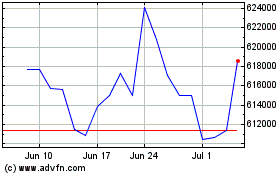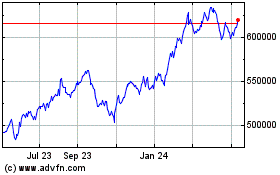Should You Follow Berkshire Hathaway Into Apple Stock?
May 20 2016 - 9:38AM
Dow Jones News
By James Mackintosh
Douglas Adams had a wonderful way to navigate in the days before
GPS: the author's hapless detective Dirk Gently would simply find a
car which looked like it knew where it was going, and follow it.
Most investors are lost most of the time, and a surprising number
follow the Douglas Adams strategy: imitate someone who seems
smarter.
The sheer amount of money behind such copy-and-paste strategies
was on show this week when Berkshire Hathaway revealed it had
bought $1 billion worth of Apple shares in the first quarter.
Berkshire chairman Warren Buffett is widely regarded as one of the
smartest investors of all time, and his acolytes--and plenty of
others--follow his holdings obsessively.
Not just obsessively: fanatically. The news added $18 billion to
Apple's market value on Monday. Apple's market capitalization
increased as much as the next five biggest gainers in the S&P
500 combined.
Copying Mr. Buffett makes some sense, assuming it was indeed Mr.
Buffett who made the investment, not one of his two deputies
charged with running big investment portfolios. He is a (very)
long-term investor with a good eye for quality companies that tend
to do well over time.
Mr. Buffett may be more famous than most, but the portfolios of
the leading hedge funds, disclosed in regulatory filings known as
13-Fs, attract significant attention, too. A mini industry has
grown up online allowing investors to track what the hedge-fund
stars are doing, and imitate their financial heroes. Investment
banks are also in on the game: several have created indexes of the
shares the big hedge funds prefer.
But academic evidence shows investors should be cautious about
simply trying to mimic what hedge funds are up to. For starters,
the information is imperfect. The 13-Fs show only U.S. shares the
funds have bought, or taken options on. They ignore short bets,
foreign stocks, bonds and futures. They are delayed by up to 45
days (Monday was the deadline), giving agile hedge funds plenty of
time to change their mind and dump a stock. And about a third of
their holdings are missing entirely, as they ask the SEC for
permission to keep them secret.
The past year's pummeling of crowded hedge-fund trades suggests
that at times it pays to do the exact opposite what the supposed
"smart money" is up to.
Start with the good news: Shares do indeed go up after big-name
managers disclose positions. But the effects wear off quickly, or
are small. Research this week from S&P Global Market
Intelligence shows that buying stocks in which the biggest hedge
funds had increased their holdings most, and selling those they cut
back the most, would have slightly beaten the market. But the
effort involved for a 0.22% average outperformance of the market
over the following month, before trading costs and tax, really
isn't worth it.
Academics have previously found a more significant two-day
effect, but that is for fast-moving day traders, not investors.
Over a month, a study a few years ago by Stephen Brown of New
York's Stern School of Business and Christopher Schwarz of the
University of California found no impact from 1999 to 2008.
Tweaks can improve the figures. Taking just the "best ideas" of
the biggest hedge funds--the stocks they hold the most of--returned
an extra 0.49% over a month, according to S&P. Nice to have,
but hardly a way to Buffett-style riches, given there are only four
chances a year to try this out.
The bad news is that these small gains are interspersed with
giant losses. Hedge funds rushed for the exit this year as their
biggest holdings began to fall, and their selling made them fall
even further. A Goldman Sachs equal-weighted index of the most
popular 50 stocks held by hedgies plummeted 16% in the first six
weeks, while an equal-weighted version of the S&P 500, also
calculated with dividends reinvested, lost only 11%. Since the
index was created in November 2007, the S&P has provided a
better return than the top hedge-fund picks.
More embarrassing still for the smartest guys in the room is
that the stocks they were betting against -- or Goldman's proxy for
them--rose far more than the hedge funds' favorites, and slightly
beat the market.
It is easy to bash the stock-picking skills of hedge funds
(Valeant, anyone?). Much worse is the tendency of hedgies to crowd
into the same stocks, pushing up prices and making them all look
like geniuses, until they all head for the door at the same
time.
The 13-F filings can be very useful for spotting the moments
when hedge funds are all copying each other. That is the time to
worry that any upset might see a violent exit crush the crowded
trades. At other times the best ideas of the smartest managers, at
least those who don't trade too frequently, make a good starting
point for investors. But be warned: there's no substitute for doing
your own analysis.
Write to James Mackintosh at James.Mackintosh@wsj.com
(END) Dow Jones Newswires
May 20, 2016 09:23 ET (13:23 GMT)
Copyright (c) 2016 Dow Jones & Company, Inc.
Berkshire Hathaway (NYSE:BRK.A)
Historical Stock Chart
From Mar 2024 to Apr 2024

Berkshire Hathaway (NYSE:BRK.A)
Historical Stock Chart
From Apr 2023 to Apr 2024
